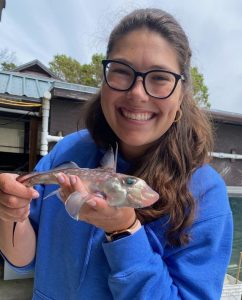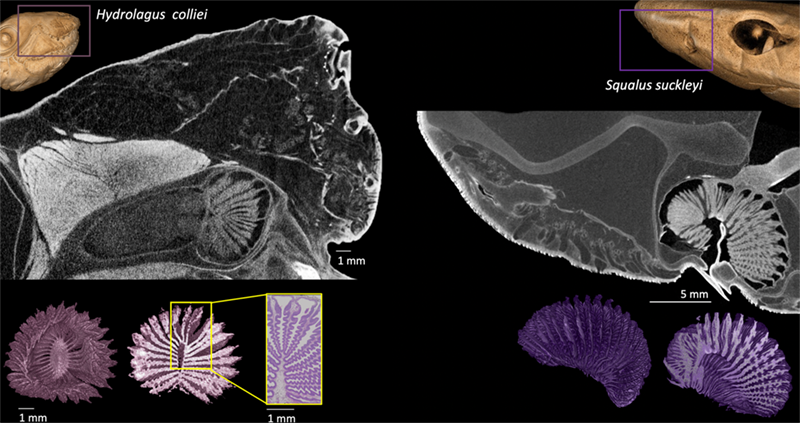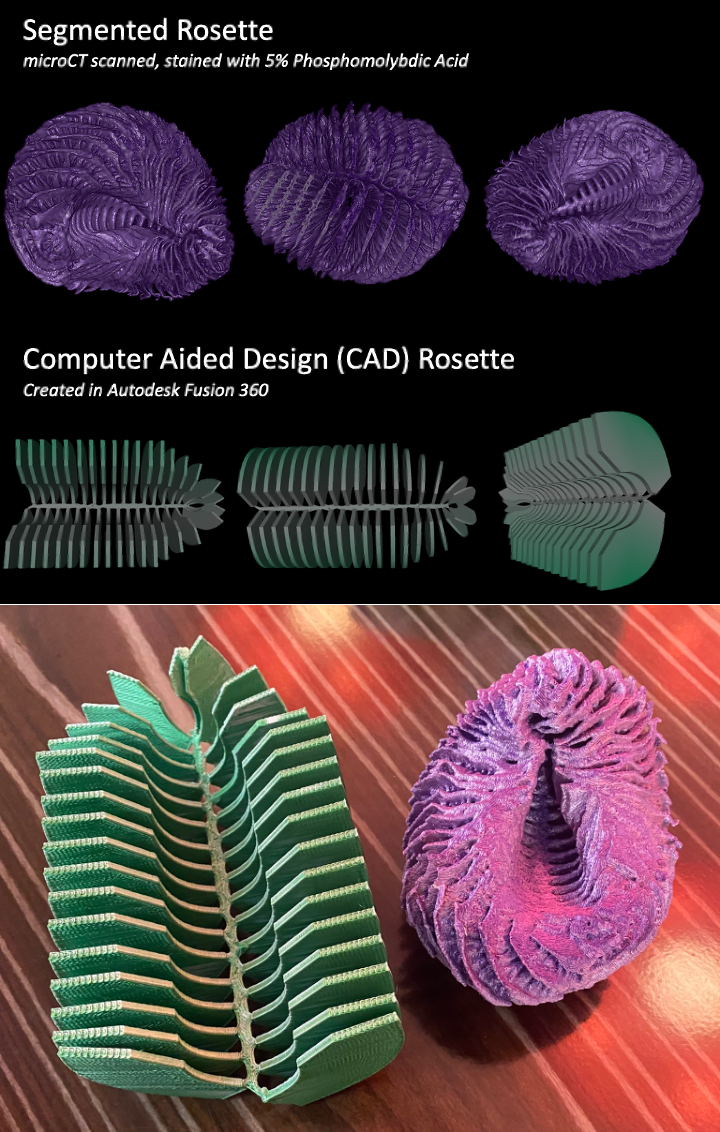Sharks, like few other organisms on earth, hold a broad and deep fascination for humans. In this month’s Tide Bite one of our current postdocs, Lauren Simonitis, describes her research into the (in)famous but remarkably under-studied sense of smell of sharks. She also shares the importance of a fantastic organization she is affiliated with: Minorities in Shark Science (MISS)!
Postdocs play a critical role in the FHL community. Lauren and our other postdocs are deeply committed not only to their research but also to mentoring and collaborating with fellow scientists including students – leading to wonderful networking opportunities for all.
Best,
Dr. Megan Dethier
FHL Director
Please help support postdocs through the Calvin FHL Postdoc Fellowship and students through the FHL Adopt-a-Student Program!
Taking a Nose Dive into Shark Olfactory Morphology
by Lauren Eve Simonitis

Lauren is an aquatic sensory biologist born and raised in Miami, FL. She has dual Bachelors of Science degrees in marine science and biology from the University of Miami’s Rosenstiel School of Marine and Atmospheric Science and a Ph.D. from Texas A&M University. Her work focuses both on how animals sense their environment and how they interact with the senses of other animals, for example how prey species can weaponize chemicals to attack sharks’ sense of smell. She arrived at the Labs in September 2021 as a Friday Harbor Labs Calvin Postdoctoral Scholar and is currently an NSF Postdoctoral Research Fellow in Biology where she continues to study the physiology and morphology of shark noses.
Sharks have gained quite the reputation for being super smellers. We see this in popular media: movies, TV shows, and even documentaries will depict the same trope – a shark gets the faintest whiff of blood and is whipped into a frenzy. Sharks have even been referred to as “swimming noses” due to their behavior and the sheer size of their olfactory structures. However, recent research has shown us that this might not always be the case. For all of the hype around shark noses, we also really don’t know that much about how they work.
Sharks and their relatives (skates, rays, and ratfish) come in all shapes and sizes and inhabit a wide variety of habitats. They can be spotted in shallow coral reefs, arctic ice fields, the dark deep sea, the open ocean, and even in the kelp beds around FHL. Shark noses are just as diverse as their habitats. Hammerheads sport long, tubular olfactory organs that match their elongated heads while sharks with pointier heads, like our local Pacific spiny dogfish (Squalus suckleyi), have more of a ball-like nose. Another local favorite, the spotted ratfish (Hydrolagus colliei), has a nose which sports a starburst arrangement of nasal structures. This variation persists when we look at all parts of the olfactory system including the nostrils, the nerves, and the brain areas. Looking around at all these morphological differences, I started wondering how the shape of a shark’s nose impacts how water flows within the nose and how the sensory structures of the nose are distributed.
Before coming to FHL, I worked on bonnethead shark (Sphyrna tiburo) noses. I found that regions of the nose where water flows had a larger sensory area than areas where water moves slower (Simonitis and Marshall, 2022). Does this relationship hold up in other cartilaginous fish with differently shaped noses? Does the location and density of sensory structures relate to water velocity, setting the range of sensitivity for specific regions of the nose?

Since arriving at FHL, I have used all the incredible bioimaging tools at the Labs to answer this question. Through a combination of contrast enhanced microCT, scanning electron microscopy (SEM), and histology, I have been describing the noses of cartilaginous fish species from our local waters (Figure 1), from collaborators across the country, and from preserved specimens in the collection. With a structure as complex and understudied as a shark nose, it’s useful to simplify the anatomy and start asking basic questions. With Dr. Adam Summers, I have been generating and 3D printing computer aided design (CAD) models of idealized noses (Figure 2). These allow us to strip the morphology down to the most simplified version, test how water flows in this basic model, and then build upon it again, adding back the anatomical complexity.

In order to understand how water moves inside the nose, we have to take a step back. We need to look at how it gets there: through the nostrils. This summer, I worked with one of our students from Ecology and Morphology of Fishes, Amani Webber-Schultz, to look at the morphology of the dermal denticles around the nostrils of Pacific spiny dogfish. Dermal denticle shape and orientation direct water flow around the body – so how do they affect water flowing along the underside of the head and into a tiny nostril opening? Amani described the morphology and directionality of the nasal dermal denticles using SEM and microCT and correlated it with water flow via dye visualization in the flume (Figure 3). These data are laying the groundwork for new understanding about how water flows into shark nostrils.

Working with Amani this summer was also extra special because in addition to our shared affinity for shark noses, we are both heavily involved with Minorities in Shark Science (MISS). MISS is an organization founded by four Black women (Amani being one of them) which promotes diversity and inclusion in shark science, encouraging gender minorities (women, trans men, nonbinary folks, etc.) of color to push through barriers and contribute knowledge in marine science. With the notable exception of Dr. Genie Clark, shark science is historically a very white and very cis-male field. In the same way that we need to study a diversity of sharks to better understand their morphology and physiology, shark science needs a diversity of people doing this research. I never labeled myself as a shark scientist until I found MISS, the first shark science space where I saw not only other racial, ethnic, and gender minority shark scientists but Latina shark scientists. I am so grateful not only to have met Amani through MISS, but to have the opportunity to do cutting edge shark research with her here at the Labs. This would have never been possible without the support of the FHL community.
References:
Simonitis L.E. and C.D. Marshall. 2022. Microstructure of the Bonnethead Shark (Sphyrna tiburo) Olfactory Rosette. Integrative Organismal Biology: 4. https://doi.org/10.1093/iob/obac027.
https://www.laurenevesimonitis.com/
https://twitter.com/oceanexplauren
